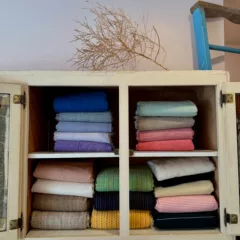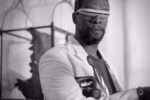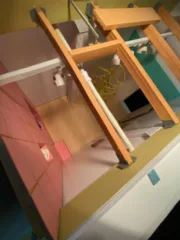The latest show at FJORD Gallery, Bleach Blue, seems to be in pursuit of an aesthetic all its own. Curator Sean Gerstley wanted to have a show including works in several media that was rigorous and linked by the notion of “bleach blue,” both as a color and just in the sound of the words, signifying an idea, a genre, and almost its own style of art. Whatever is meant by “bleach blue” is likely different to each viewer, represented by whatever linkage they can find between the diverse, almost schizophrenic medley of nine pieces in this show.

Katie Bell’s installation “The Maiden” is a room interior ripped apart and deconstructed, then glued back together on the wall like a digested, regurgitated meal. It’s questionable what kind of building exploded in the making of this piece, but pieces of linoleum tile give the feel of a domesticity. Overwhelming and barely bound together, the piece creates its own violent and chaotic order.
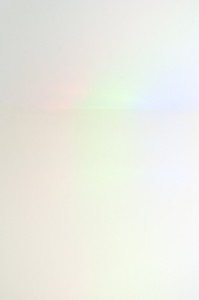
Contrasting nicely with Bell’s chaotic arrangment, “Rainbow” by Amy Maria Harbilas exists at the edge of optical perception, subtle and barely discernible from the white wall it is mounted on. A full range of color is in the digital print, but so muted and oblique as to hover on the edge of non-existence. Seemingly placid, the piece’s faintness actually agitates the eye while pulling it inside, searching for an object. Only on an illuminated computer screen could the greasy, wide strokes of color or the horizon they seem to traverse be seen clearly.
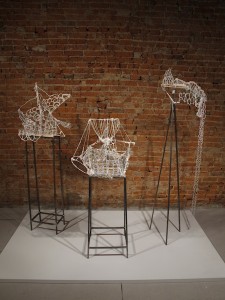
Named after the structures they are placed on, Ester Kislin’s abstract sculptures are skeletal outlines of shapes both organic and inorganic. They reward close engagement from various angles with ambiguous and thought-provoking form.
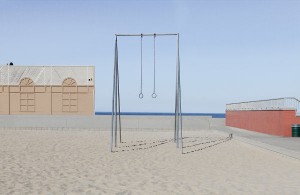
Thought provoking in a more concrete, real-world (or dream world) way, Lauren Marsolier’s photography, with its austerity and strong geometric lines, toes the line between reality and a digitally created alternate world. This photograph exemplifies her current body of work, where washed out, shadowless landscapes with impassive buildings form a reinterpretation — a sterile dreamscape — of what appears to be the artist’s native California.
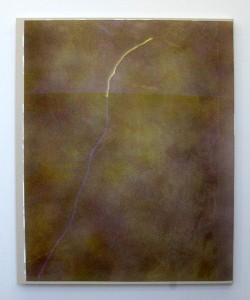
“Tether” an acrylic painting by Collin Hatton experiments with tactility and transparency. The piece centers around a vibrant, electric line which defines itself out of an organic murk. Layers of color emerge as the viewer changes perspective. This illusory sensation is due in part to the artist’s technique of painting through a screen, creating the effect of cavernous depth.
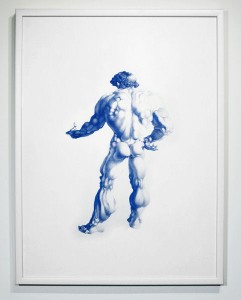
As crisp as Hatton’s painting is murky, Armando Veve’s drawing of an intensely stippled re-imagining of a classical David-like figure is humorous and self-aware of its bizarrely-muscled subject. Like other pieces in the show, the image is created with a light touch, giving it a transitory sensibility.
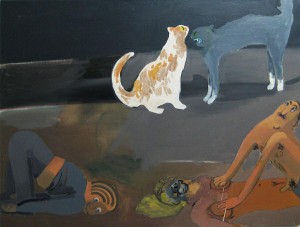
Standing in a zone all its own, Heidi Hahn’s playfully demonic painting in the backroom is cartoony and weird. It also has a unique combination of the array of elements common through most of the paintings she has posted on her website: cats, sexual activity, figures sprawled on the floor, and the strange mask-like face of the lying figure at right. The composition between the legs of the bodies doesn’t indicate how prevalent strong architectural vertical lines and presences are in most of Hahn’s other works, which at times border on a significance akin to that of works by de Chirico. The twisted interplay between the figures and mixed darkness of the receding floor are strange but integral elements of this dreamy work.
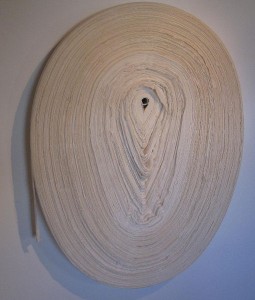
Also in the exhibit are Tim Eads, with his a mega-toilet paper roll that’s almost nauseating as a statement on waste but humorous in an art gallery, and Ginger Lukas, with a non-functional Play-doh fire hydrant/flower vase that seems ready to come to life as a bizarre Sesame Street character.
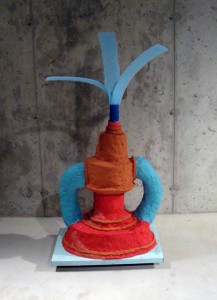
Is a washed-out, partly-bleached sensibility the essence of “bleach blue?” Or is the phrase just a meaningless phrase serving as a place-holder to organize a collection of art by your friends and people you like? Only in “Drawing of a Bulbous Man” by Veve does “bleach blue” feel like a presence, instead of an absence. Marsolier’s photography literally feel bleached of color and vitality, while the works of Harbilas, Hatton, Kislin and Bell feel like they have been bleached or drained of definable subjects. Maybe seeing the world through bleach blue-tinted glasses means seeing less instead of more. If that leads to more stimulating abstractions in the vein of the works at this show, this unique aesthetic might be worth pursuing.
Bleach Blue will be up at FJORD, at 2419 Frankford Ave., through November 14, with a closing reception scheduled for November 8 at 7 p.m.


